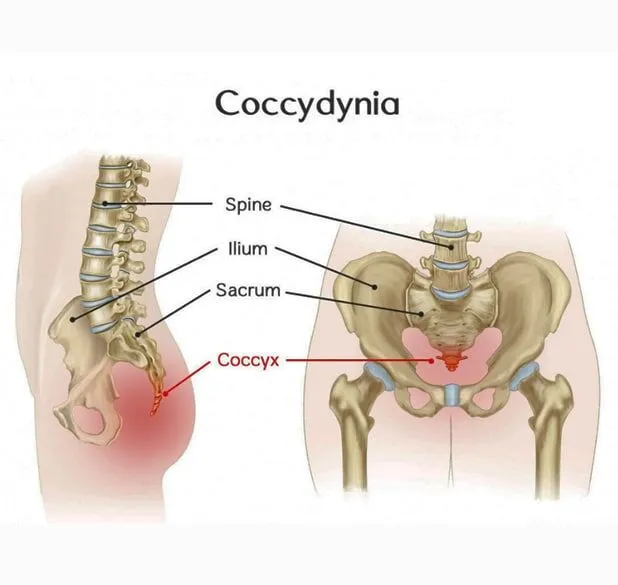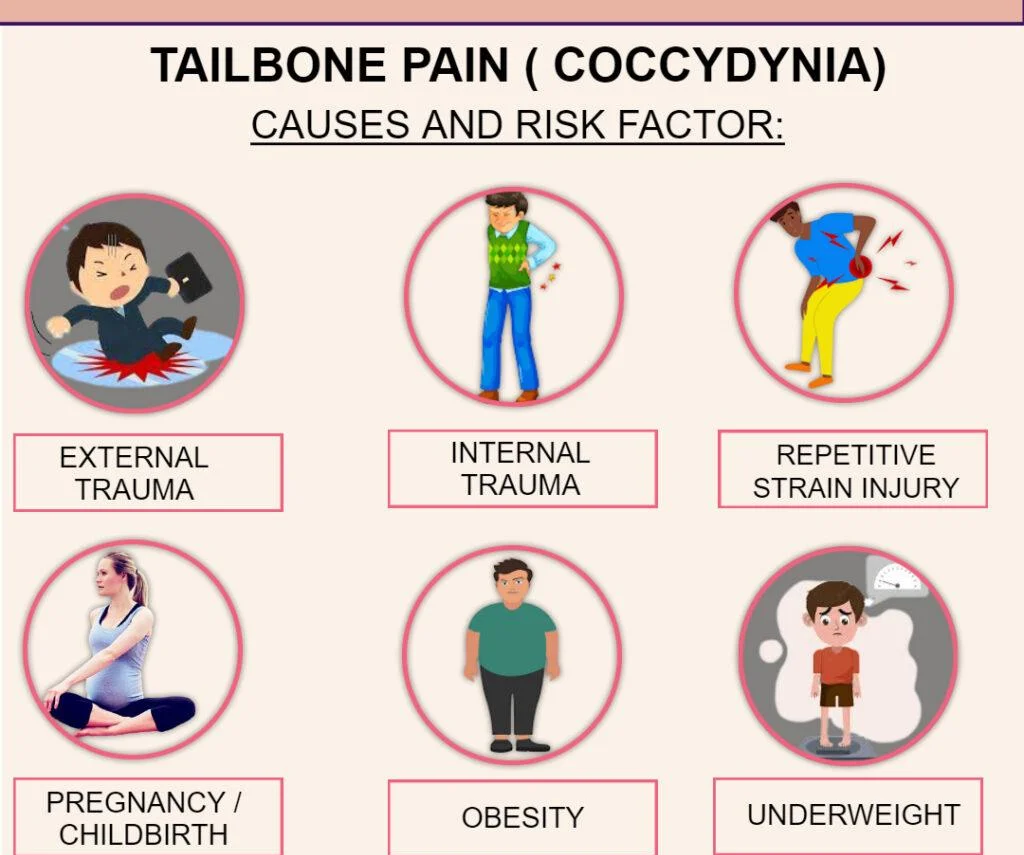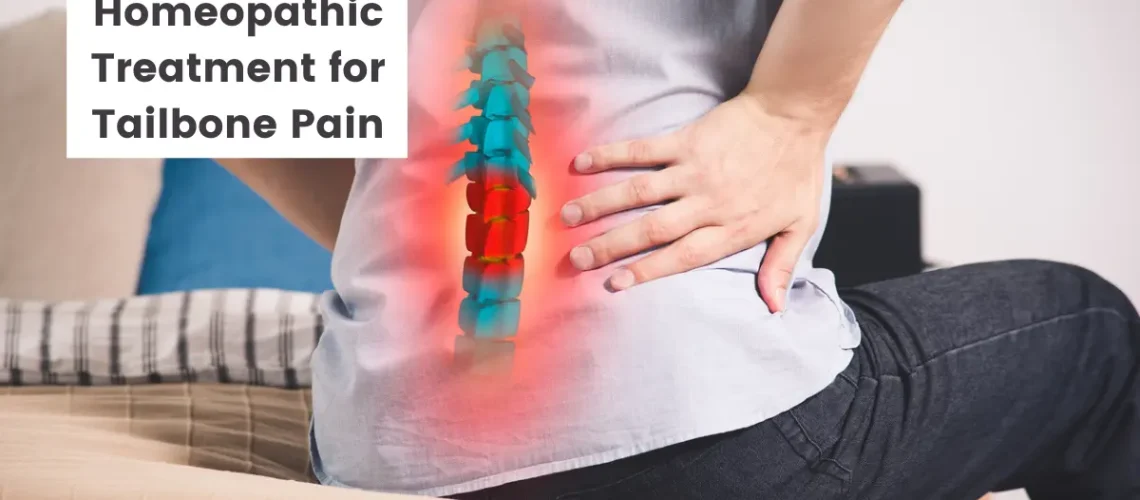The tailbone is a triangular bony arrangement that makes up the very lower end of the spine below the sacrum and is medically termed a coccyx. The lower back is called the lumbar vertebrae followed by the sacrum and in the coccyx the tailbone.
Falling on the tailbone can lead to coccygeal pain, known as coccydynia, resulting in chronic inflammation of the sacrococcygeal joint.
Dislocation of the coccyx occurs when there is the separation of the coccyx from the sacrum.
The tailbone or coccyx is a shock absorber when sitting it shifts slightly forward. The coccyx bears more weight when the person is sitting and leaning backward compared to when leaning forward.
This article will cover homeopathic remedies for tailbone pain, the causes of the tailbone pain, symptoms, risk factor, and its prevention and management.

Table of Contents
ToggleCauses of Tailbone Pain
There are many causes linked to the tailbone pain that is mentioned below.
1. Result of the fall
Many patients experience coccydynia or tailbone pain as a result of a fall as with a tailbone fracture. This is one of the most common causes of tailbone pain.
A fall on the coccyx can be resulting in the inflammation of the ligaments and injure the tailbone or the coccygeal attachment to the sacrum.
Direct injury to the coccyx results in bruised bone, dislocation, or even fracture.
2. Repetitive stress
Another cause behind the tailbone pain is repetitive stress. Some activities put prolonged pressure on the tailbone such as horse riding, and prolonged sitting on a hard surface.
These activities may cause the onset of tailbone pain. Although it is temporary if not corrected or treated on time then it leads to some serious problems like inflammation, soreness, dislocation, and long-term altered mobility of the sacrococcygeal joint.
3. During childbirth
Tailbone pain can occur during pregnancy and labor and is another major cause of coccydynia.
During childbirth, the head of the baby passes over the top of the coccyx and can sometimes result in injury to the disc, ligament, and ones around the coccyx.
Patients are more likely to have tailbones if they have any instrumental delivery or baby is in the face-up position.
4. Obesity
Being overweight or obese is another biggest factor and one of the major causes of developing tailbone pain.
The extra weight in the body alters how the patient sits and applies additional pressure to the coccyx and can cause it to lean backward. The tailbone gets out of its position and will hurt later.
The lower part of the coccyx can pinch the surrounding area and cause pain and discomfort while sitting.
5. Chordoma
Chordoma or sacral tumor is a slow-growing cancer of the spinal tissue. It can occur anywhere in the spinal cord or the base of the skull. It is most commonly found near the tailbone and is one of the main causes of tailbone pain.
Although it is a rare type of cancer if seen in any patient then he will suffer from coccydynia because of the pressure put on the coccyx due to growing tumors in the spine.
6. Degenerative disc disease
Degenerative disc disease or DDD is a very common cause of tail bone pain. It is also called osteoarthritis of the spine and develops due to loss of cushioning between the vertebrae.

Types of Tailbone Pain Due to Injury
The types of tailbone injuries are mentioned below
1. Anterior dislocation
The anterior dislocation of the coccyx is one of the types of coccygeal injury where the sacrococcygeal joint gets dislocated and the coccyx or tailbone gets separated from the sacrum.
The cause behind the anterior dislocation is an acute trauma mainly.
2. Posterior dislocation
The posterior dislocation of the coccyx is a rare condition and can occur due to acute trauma from a fall into the buttocks or some underlying chronic disease.
In posterior dislocation of the coccyx, the joint is mainly involved in the mid coccygeal joint and can lead to chronic pain.
3. Anterior angulation
The anterior angulation of the coccyx is usually a normal variant but it may possess a diagnostic challenge for those considering coccygeal trauma.
The excessive anterior angulation of the coccyx is caused by many reasons but the most common is natural birth and chronic irritation of the coccygeal area for example long sitting, cycling, horse riding, etc.
4. Hooked coccyx
The sacrococcygeal joint is a synovial joint that is supposed to have movement. There are three or four tiny little bones that are part of the coccyx and when you sit down the coccyx is supposed to flex forward. This joint is to be mobile but very commonly it gets osteoarthritic and does not want to flex forward when you sit, this coccyx gets stuck and hook.
Very commonly the hooked coccyx presents with a left-side shift other words left side bent coccyx.
Symptoms of Tailbone Pain
The symptoms of tailbone pain or coccydynia include:-
- More severe achy or piercing pain in the tailbone, especially when changing from sitting to standing up
- Severe pain on long sitting
- Back pain
- Tenderness in the coccyx region
- Pain gets worse on leaning forward or backward
- Pain also gets worse during intercourse and menses.
- Difficulty in defecation
- Depression
- Anxiety
- Disturbed sleep
- Pain origination in the middle just above the anus
- The distraction of the mind due to pain
- Severe pain or sciatica-type pain in the pelvis or legs.
Risk factors of Tailbone Pain
- Now the question arises who is at great risk of developing tail bone pain? Well, it can be seen in age groups and is mainly linked with acute trauma due to direct falls on the buttocks
- People who have a full-time sitting job are more inclined to develop coccydynia due to prolonged pressure on the coccyx bone by long sitting, patients can develop coccydynia and are at higher risk.
- Studies say that women are at greater risk of developing tailbone pain than men. Because during childbirth there is a chance of dislocation or fracturing of the coccyx that eventually leads to developing coccydynia.
- Some underlying diseases in people such as bone-related pathology, degenerative disc diseases, etc. can also later develop into coccydynia.
- The person who is underweight and who is extremely lean and emaciated is at great risk of tailbone pain. Extra weight applies extra pressure on the coccyx region in obese people and lean thin people who do not have flesh around the buttocks and coccyx region that can provide cushioning on falls.
- The tailbone is also very common in toddlers because of their unsteady walk they stumbled very easily and slip on their buttocks.
Diagnosis of Tailbone Pain
The diagnosis of tailbone pain begins with a complete medical history regarding onset, modalities, and severity of the pain and physical examination, and is usually made by clinical examination that is by signs and symptoms experienced by the patients.
If you are experiencing the symptoms such as piercing pain in the coccyx region, local tenderness, and difficulties in changing the position from sitting to standing, then the doctor will perform some tests to confirm the diagnosis.
The doctor will ask about the medication and disease history that the patient is taking or whether the patient has bone-related pathologies, or any genetic disorder or not.
The doctor will also ask about some associated symptoms along with tailbone that patient may experiencing or not.
The doctor may also perform some physical examination by looking at the back and pressing and palpating it with hands for checking any dislocation or fracture and local tenderness. To clear and confirm the diagnosis he will also recommend the patient for an X-ray and MRI.
A static image of the tailbone will be taken by MRI or CT scan to check if the suspected cause of pain is a fracture, tumor, or abnormal mobility of the sacrococcygeal joint.
In rare cases, routine blood tests are obtained to rule out the possibility of an infection or tumor.
Prevention and Management of Tailbone Pain
- Conservative, non-surgical, and preventive measures are typically the gold standard when treating tailbone pain or coccydynia.
- The initial goal of prevention and management should be focused on providing postural education. The individuals should be taught to correct their posture while sitting and sit erectly on a firm chair.
- To prevent neck tenderness, backache, and tailbone pain person can also have a wedge-shaped or coccygeal cushion that helps to relieve the pressure during sitting.
- Some exercises are also very helpful in relieving the pain and can be performed individually without the help of any physiotherapist. Such as pigeons pose, child pose, single-leg knee hug, weightless squats, and hamstring stretches.
- Applying heat on swollen tender areas or ice if there is internal hemorrhage after a fall can help to relieve the pain.
- You can also relive the pain through manual manipulation. By doing so the joint between the sacrum and coccyx can be adjusted, potentially reducing pain caused by inadequate coccyx mobility.
- Tailbone pain may be reduced or alleviated by massaging tense pelvic floor muscles that attach to the coccyx.
Best Homeopathic Medicines for Tailbone Pain
Homeopathy is a holistic system of medicine that treats not only the symptoms of the disease but also the man who is suffering from the disease.
So, after a complete detailed history of present and past disease and considering the family history also, a drug is prescribed which will be based on the individualization of every patient.
In mild cases, improvement can be seen within weeks, whereas severe cases will take a longer time. Along with homeopathic medicine, the patients have to follow a healthy regimen for optimum results.
Now, let’s go through some of the homeopathic medicines that can help in tailbone pain. Some of the best homeopathic medicines for the treatment of tailbone pain are mentioned below.
- Aesculus hippocastanum
- Arnica montana
- Bryonia
- Calcarea Carbonica
- Calcarea phos
- Rhus tox
- Nux vomica
- Natrum muriaticum
- Cimicifuga
- Hypericum perforatum
1. Aesculus: for backache worse on walking and stooping
Aesculus is a highly effective medicine for treating back-related problems including coccydynia. This remedy is indicated when there is lameness in the neck and between the scapula also the back and leg give out and the region of the spine feels weak.
Backache is so severe that it affects the sacrum and hips and is worse on walking and stooping.
Dosage and potency: 30c, 200c 4 globules (pills) dissolved in half a cup of water 2 times a day for 15 days.
2. Arnica: for tailbone pain due to falls and blows.
Arnica is one of the first aid remedies that is given when there is injury due to a fall and blows along with contusion in the local area.
This medicine is highly effective in treating tailbone pain when the cause is acute trauma of a fall on the buttocks.
Arnica can be given after traumatic injuries, overuse of the back for e.g prolonged sitting at one place, and in case of repetitive stress.
Dosage and potency: 200c, 4 globes in half cup of water thrice a day till the symptom disappear.
3. Bryonia: backache from the sudden change of weather
Bryonia is a wonderful remedy and is indicated when there is aching in every muscle and the general character of pain produced is stitching and tearing type.
These characteristics stitching pain is greatly aggravated or become worse by any motion and by pressure.
Bryonia can be given to the patient in the treatment of tailbone pain when he experiences a painful stiffness in the lumbar region.
Dosage and potency: 30c, 200c, take 4 drops of dilution in half a cup of water twice a day, till the improvement is seen.
4. Calcarea carbonic: tailbone pain from over lifting
Calcarea carbonic is a polychrest remedy and has an action on almost every organ of the body. Its chief action is centered in the vegetative sphere, the glands skin, and bones.
There is feeling in the back as if sprained and a patient can scarcely rise.
It is generally indicated when the patient experiences tail bone pain after over lifting, repetitive stress, or rheumatism in the lumbar region.
Dosage and potency: 200c potency take 4 globules (pills) twice a day till the improvement occurs.
5. Calcarea Phos: for soreness in the hip joint
Calcarea phos is a wonderful tissue remedy and is highly effective in treating bone-related pathologies. It has a special affinity where bones form sutures or symphyses and all its symptoms are worse from any change of weather.
It is indicated when there is soreness in the sacroiliac symphyses or the hip joint with a feeling as if broken.
Dosage and potency: 1m potency of dilution, take 2-3 drops in half cup of water one time a day for 3 days.
6. Rhus Toxicodendron: for pain and stiffness in the base of the spine
Rhus tox is a highly effective medicine in post-operative complications and is often indicated to treat tail bone pain and backache.
There is extreme restless with continuous change of position with great apprehension at night.
There is a pain in the lumbosacral region which gets better by motion or lying on something hard and becomes worse while sitting.
Dosage and potency: 30c, 200c potency, take 2-3 drops of dilution in half cup of water and take twice a day till the improvement.
7. Nux vomica: for burning in the spine
Nux vomica is the greatest polychrest remedy and is preeminently the remedy for many of the conditions incidents to modern life.
It is indicated when there is a sensation of bruised pain and burning in the spine. It is also indicated for backache in the lumbar region. The patient must sit up to turn in bed although sitting is painful.
Dosage and potency: 30c, 200c, 4 globules (pills) twice a day till the improvement is seen.
8. Natrum muriaticum: for tailbone worse by lying down
Natrum Mur is a highly effective medicine for treating the tailbone along with great weakness, weariness, and oversensitive to all sorts of influences.
It is the remedy for nutritive changes in the system due to prolonged intake of excessive salt resulting in the retention of effete materials in the tissue giving rise to the symptoms of rheumatic gout.
There is a pain in the base of the spine and the whole back with a desire for some firm support.
Dosage and potency: – 200c potency, take 4 globules thrice a day up to improvement.
9. Cimicifuga racemosa: for very sensitive spine
Cimicifuga has a wide action on the cerebrospinal and muscular systems. Its muscular and crampy pains, primarily of neurotic origin, occur in nearly every part of the body.
The spine is very sensitive, especially the upper part. It is also effective in relieving tailbone pain. There is also rheumatic pain in the muscles of the lumbar and sacral region through the hips.
Dosage and potency: 30c, 200c take 3-4 drops of dilution in half a cup of water twice a day.
10. Hypericum: for coccyx injury from fall
Hypericum is a great remedy for injuries to nerves, and excessive painfulness is a guiding symptom for its use.
It is a highly effective medicine in treating tailbone pain especially when there are injuries to the coccyx after a fall and the pain radiating up the spine and down the limb. There is also jerking and twitching of the muscles of the back.
Dosage and potency: 200c potency, take four globules under the tongue, twice a day for 15 days or until the improvement appears.
Remember that homeopathic remedies should be prescribed based on individual symptoms and characteristics. It’s crucial to consult with a qualified homeopath for proper evaluation and personalized treatment. Homeopathy focuses on treating the whole person, so a detailed case study is necessary to select the most appropriate remedy.
Homeopathic medicines should be taken only when prescribed by a homeopathic physician. Self-medication may aggravate the original conditions.

